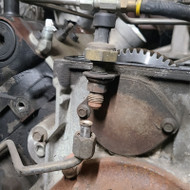7.3L Powerstroke - Exhaust Back Pressure Sensor Diagnosis
Posted by Adam Blattenberg on Apr 23rd 2025
The 7.3L Powerstroke doesn’t have too many sensors compared to more modern era diesel’s, but the ones it does have all play important roles. This week, we’ll be diving into the Exhaust Back Pressure Sensor’s (EBP) operation and common issues associated with it. The EBP sensor's job is to measure the pressure in the exhaust manifold before the turbocharger. The PCM then uses the data to control the exhaust back pressure valve for faster warmups, as well as for controlling how the engine runs during normal operation by altering the fueling and timing tables. You can find the EBP sensor on the front of the HPOP reservoir on the 1999-2003 7.3L and around the back of the reservoir on the 1994-1997 7.3L. It looks similiar to the ICP sensor and has a tube connected to the bottom. This tube runs back to a fitting on the passenger side exhaust manifold.
So what happens when the EBP sensor isn’t working correctly? Many things are possible.
Slow warm-ups (when ambient temperatures are below 40 degrees Fahrenheit) due to the Exhaust Back Pressure Valve (EBPV) not being commanded correctly from the PCM. Smokey starts when cold are also a symptom here.
The PCM might not adjust fuel delivery correctly based on engine load, potentially leading to slightly reduced power or efficiency, especially under heavy throttle or towing. This can rear its head in the form of sluggishness, hesitation when accelerating as well as noticeably reduced MPG.
So what do I look for when diagnosing? Although not unheard of, the EBP sensor does not commonly fail on its own. The most common issue related to the EBP sensor is from a clogged backpressure tube. It simply fills with soot and won’t supply the exhaust pressure the sensor/PCM needs to see. It often reads lower than actual pressure, sometimes just atmospheric pressure. Cleaning or replacing the tube will fix most issues.
Wiring failure, aka frayed wires, is also fairly common especially as these engines grow in age. Check your wires, connectors and pins. Frayed wires are most common here, but also check to make sure the pins are actually engaged/making good contact.
The EBP valve (EBPV) could also have failed, although thats very uncommon. Check for oil leaks in the valley coming from under the turbo. That could indicate a failed EBPV, however it may indicate a turbo oil seal leak as well. We've also seen EBPV failures where the valve itself has physically broken. Again, very uncommon but worth mentioning. In either case, oil leak or failed valve, the turbo is coming out to fix it. Once it's out the valve is easy to see. If you're pulling the turbo, we highly recommend replacing the pedestal with one of our Non-EBPV pedestals that removes the EBPV altogether.
Last would be a failure of the sensor itself.
To help diagnose your issues, we’ve included the following codes you may see related to the EBP sensor. We’ve added what they commonly mean, however using your own diagnostic skills and knowledge is paramount. Codes don’t always point directly to the culprit.
Related Codes:
P0470: EBP Sensor Circuit Malfunction (often times sensor or wiring related)
P0471: EBP Sensor Range/Performance (most common when the tube is clogged or leaking)
P0472: EBP Sensor Low Input (often times sensor or wiring related, also clogged tube related)
P0473: EBP Sensor High Input (often times sensor or wiring related)
P0478: Exhaust Pressure Control Valve High Input (Sometimes related if the PCM tries to overcompensate based on a bad EBP reading).
In the end, nine times out of ten, the tube is clogged. Remove the tube and clean it but also make sure there’s no holes in it from corrosion. If there are holes, replace the tube. If you need a tube or sensor, we generally have both in stock ready to ship. If the tube is good, check your wires, if they're good, a new sensor may be your next step.





















































